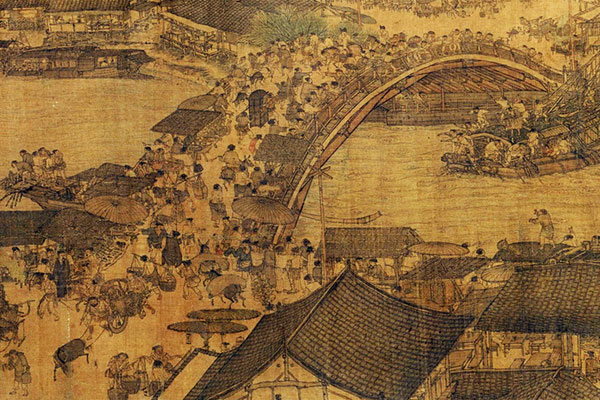
Part of the painting, Along the River During the Qingming Festival, reveals the 12th-century urban life in Bianliang, an ancient Chinese city.[Photos provided to China Daily]
Zhang Zeduan’s famous work, Along the River During the Qingming Festival, created during the 12th century has inspired a modern day author.
For many Chinese, Qingming Festival, also known as Tomb Sweeping Day, which falls on April 5 this year, is associated with a famous painting created by Zhang Zeduan during the Northern Song Dynasty (960-1127).

The 5.28-meter-wide and 0.24-meter-high Along the River During the Qingming Festival vividly depicts life along the banks of the Bianhe River, which flows through Bianliang, the capital city of the dynasty and today’s Kaifeng city in Henan province.
A recently published historical thriller, Qingming Shanghe Tu Mima (The Code of the Painting Along the River During the Qingming Festival), tells the story of a major conspiracy depicted in the seemingly peaceful scene, which leads to the fall of the Songs.
The scroll painting features more than 800 people doing various activities. Farmers are sowing seeds in the fields, people are walking in the streets, sweeping graves and eating. Children are flying kites, merchants are selling goods, workers are driving carts, officials are riding horses and women are walking with baskets in hand.

In Qingming Shanghe Tu Mima, Chengdu-based writer Ye Wenbiao gives each figure a name and a role, bringing them to life. He weaves the characters into his “big history” fiction, in which the author sets during a critical period, creating a story based on historical records.
“There is always some mystery that historians cannot explain. So I use my logic and imagination to fill in the gaps,” Ye, 43, says.
This is his second book in the genre. The first is about the disappearance of an ancient version of the Analects of Confucius, set in the Han Dynasty (206 BC-AD 220).

The idea for a book about the painting came to Ye when he first saw a copy of it during a visit to Kaifeng 10 years ago. The original painting is in the Palace Museum in Beijing.
“I was amazed by the painting that showed the lively urban life of the Northern Song Dynasty,” recalls Ye. “And then I began to ask — why did such a prosperous dynasty collapse so quickly?”
According to historians, that dynasty lost control of northern China to the Jin Dynasty (1115-1234) and retreated to the south in 1127, just a few years after the painting was completed.
Ye bought a copy of the scroll and nailed it to his bedroom wall.
“I am awed by the superb artistic skill of the painter, and moreover, as a storyteller, I am interested in the stories behind each figure in the painting,” says Ye.
“I started to imagine the background, characters and destiny of those people, and associated them with the historical period. I just can’t help but tell the story.”
Ye studied the painting intently and began to imagine that a big ship that is about to pass through an arch bridge is somehow suspicious. The painting depicts a dramatic scene as the ship is getting close to the bridge but it hasn’t lowered its mast. The people on the bridge and along the banks are shouting to alert the ship, and the crew is busy fixing the problem.
Ye thinks that the mast is obviously higher than the bridge and the river flows slowly, so the crew should have noticed it long before the ship neared the bridge. This unusual incident in the painting is the beginning of the thriller.
The main character in the book is a descendant of the royal family who helps people resolve criminal cases. Because of his occupation, he and his family become involved in a series of strange murders which connect to each other and lead to a big mystery concerning the destiny of the whole country.
In order to faithfully represent the customs and traditions of the time, Ye spent three years reading every historical record he could find about the Song Dynasty before he started writing the novel in 2013.
Ye plans to write six installments in the series, with each one telling the story of a group of people, such as officials, farmers and merchants to give a comprehensive representation of society back then.
“I will write about all 824 people in the painting. In the first installment I have written about 149 people,” says Ye.
“In the end, all of them will become involved in a significant historical event that will change everyone’s life.
“It’s a real event from history, but at the moment I cannot reveal what it is.”
